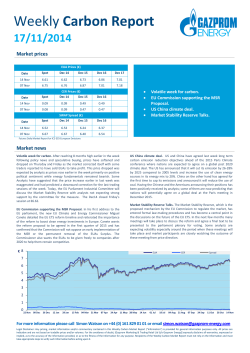
The Global Week Ahead - Global Banking and Markets
Global Economics December 24, 2014 The Global Week Ahead Derek Holt (416) 863-7707 derek.holt@scotiabank.com Opa! Shouting ‘Opa’ loosely means ‘oops’ and usually follows breaking plates as praise for performers. It might be heard a lot next week if the Greek government falls, or if you happen to hear a glass of champagne falling to the floor. Possible Greek elections will govern market risks alongside global manufacturing data in an otherwise generally quiet week. Forecasts & Data Canada-US Previews A1 International Previews A2 Before we get into all that, the busiest industry on the week will likely be A3-A4 Key Indicators makers of bubbly. Of course as you raise your glasses, I know you’ll be A5 Global Auctions Calendar asking yourself “Gee, I wonder what economists have to say about how the champagne industry is doing.” Well how nice of you to ask. Suffice it to A6 Events Calendar say that elements of the industry have been a tad challenged over the crisis period. Sales of Champagne from the highly fragmented Champagne region of France with its 300 houses and 15,700 vineyard growers peaked Chart 1 in 2007 (see chart, and here for more facts). Apparently weak economies have given less reason to celebrate. Like many others, the industry has Weak Post-Crisis Champagne Sales also suffered from a supply glut in recent years, but unlike many other 350 industries, that may actually be about to worsen further. That’s because millions of bottles in 2007 — when sales peaked and supply shortages were the concern — 340 the Champagne region approved more planting of vineyards starting next 330 year. To absorb that new supply, producers had better hope that Europe’s economy goes on the mend and soon. Fifty-five percent of the 320 Champagne region’s shipments are consumed in France. Forty-five percent is exported, with the UK (10%), US (6%), Germany (4%), Japan 310 (3%) and Belgium (3%) the five biggest export markets. As for the rest of 300 Asia’s thirst? China may be buying up higher end French wines but it doesn’t even make it into the top ten of export countries for Champagne 290 despite a rapidly growing consumer class. Europe is therefore dominant as a share of Champagne sales as many of its champagne houses suffer 280 from poor export orientation. The other challenge for the Champagne 270 houses is that sparkling wines produced elsewhere have long been on 04 05 06 07 08 09 10 11 12 13 the rise. In fact, true Champagne only accounts for about 13% of world Source: Scotiabank Economics, Expedition Champagne. consumption of all sparkling wines. Europe — Champagne Corks Might Not Fly In Greece Far and away the greatest risk overhanging European and probably global markets over the next week and perhaps longer will be the outcome of the final scheduled vote in Parliament over whether to approve Prime Minister Antonis Samaras’s nomination for President (Stavros Dimas). In the first two votes, the government had to get 200 out of 300 in Parliament when it only holds 155 seats itself and so both votes failed. The third vote on December 29th, however, lowers the threshold to 180 which still at this juncture seems a remote prospect for the government to succeed. Therefore, if it goes to an election, then the polls are marginally favouring the anti-austerity elements. A poll on December 21st showed that Syriza — the main opposition party — held a slim 3.4 point advantage over Samaras’ New Democracy party. No party is dominant, however, in that Syriza polled 27.1% of votes, New Democracy pulled 23.7% of support, and then the results splinter. Our readers’ favourite, the Communist Party, polled 5.3% support. Potami (5.8%), Pasok (Samaras’ coalition partner, 4.6%), and Golden Dawn (4.4%) round out the rankings. Thus, with Pasok its coalition partner, the government could stand but only just barely and assuming other coalitions are not struck. Each side is Scotiabank Economics Scotia Plaza 40 King Street West, 63rd Floor Toronto, Ontario Canada M5H 1H1 Tel: (416) 866-6253 Fax: (416) 866-2829 Email: scotia.economics@scotiabank.com This report has been prepared by Scotiabank Economics as a resource for the clients of Scotiabank. Opinions, estimates and projections contained herein are our own as of the date hereof and are subject to change without notice. The information and opinions contained herein have been compiled or arrived at from sources believed reliable but no representation or warranty, express or implied, is made as to their accuracy or completeness. Neither Scotiabank nor its affiliates accepts any liability whatsoever for any loss arising from any use of this report or its contents. TM Trademark of The Bank of Nova Scotia. Used under license, where applicable. The Global Week Ahead is available on scotiabank.com, Bloomberg at SCOT and Reuters at SM1C December 24, 2014 Global Economics The Global Week Ahead jockeying in that regard. Samaras has offered to invite more parties into the governing coalition and hold full elections by the end of 2015 if Dimas is approved next week. Dusting off our game theory, the risk is that of strategic voting that can make for any outcome. Syriza is positioning the gesture as a further sign that the government must go as it is ‘auctioning’ off key positions in government. Syriza, however, faces the challenge of convincing voters how it would balance its goals of staying in the euro while retaining capital market access and support from the Troika as it ends austerity measures in the context of a record high debt-to-GDP ratio of about 175%. The risk is that of stoking renewed Eurozone risks. Minor data risk will otherwise consume European market attention. After a large gain in October, the volume of German retail sales is likely to flatten out or give some of it back in November’s reading. The 1.6% m/m gain in October was the strongest since the prior November and tied for second strongest within the past three years. Chart 2 The UK’s purchasing managers’ index for the manufacturing sector and a pair of Domestic Economy Trumps prints from Spain for retail sales and CPI will also be released. Repatriation Of Manufacturing United States — Bringing Home Manufacturing? One theory behind recent manufacturing strength has been that the US has been bringing home such activity from abroad over the recovery period. One of the supposed reasons for this was high energy prices that added to transportation costs that often became uneconomic. That theory didn’t really have much to support it before the recent collapse in oil prices, and it certainly doesn’t now. Witness chart 2 that compares the new orders subindex of the ISM report to the new export orders subindex. The imputed difference is domestic orders. The observation is that new export orders have been rising at a slower pace than the total order book and hence at an even slower pace than purely domestic orders. In short, one could take this as further evidence of our view that the Federal Reserve can focus heavily on the domestic economy in moving toward less stimulative monetary policy. We’ll see to what extent all of this holds when the ISM release arrives the day after New Year’s. The ISM headline reading is likely to follow regional surveys lower while still remaining solidly in expansion territory. 70 Index 65 60 55 50 45 New Export Orders 40 35 Total New Orders 30 25 20 08 09 10 11 12 13 14 Source: Scotiabank Economics, Bloomberg Other than that, US-focused risks should be fairly light at least by way of what’s on the calendars. Data releases will include S&P Case Shiller home prices that will be shooting for the second straight monthly gain after four months of declines, the Conference Board’s consumer confidence reading that could well post a further gain when it has already been around its highest levels in seven years, pending home sales that might claw back into the black, and construction spending. Asia — Are Financial Reforms Impacting China’s Smaller Manufacturers The Most? Moderately different performances are being registered in the Chinese government’s version of its purchasing managers’ index for the manufacturing sector, and the private sector’s version. The latter has recently slipped below the critical 50 line and thus into contraction territory, while the state’s version has been stubbornly holding above 50 for just over two years now. The private PMI has spent about as much time in contraction territory as it has spent signaling contraction over this period. We’ll see if that same pattern of differences between state and private Chinese PMIs holds next week when the state’s first reading for December arrives and the private version may be revised from its earlier contractionary reading. What gives? For one thing, there are differences in the readings. The private version is more skewed toward smaller manufacturers in coastal export-oriented cities. The public version is more skewed toward bigger firms with more financing choices. It’s possible that efforts to strike a balance between reforms and stimulus are sawing off in such fashion as to be moderately less harmful to the bigger firms. Regional markets will have lesser releases to focus upon including export figures from Indonesia, Hong Kong, South Korea and Thailand, industrial output from South Korea, and CPI inflation in South Korea and Indonesia. The latter two releases will provide a study in contrasts over how falling energy prices are impacting inflation readings and thus the ongoing need for evaluating emerging markets differently from one another. South Korean inflation could test new lows not achieved since the depths of the Asian financial crisis back in 1999. Indonesia, however, is cancelling out the effects by lowering fuel subsidies as a controversial step pursued by recently elected President Joko Widodo who is scoring points with economists for attempting to move toward more market friendly reforms. Canada — All’s Quiet Canada will follow the global market tone as there is nothing on the calendar whatsoever. In fact there really isn’t anything significant on the calendar until jobs data for December is released on Friday January 9th. 2 December 24, 2014 Economics Global Views Frances Donald (416) 862-3080 frances.donald@scotiabank.com Derek Holt (416) 863-7707 derek.holt@scotiabank.com Dov Zigler (212) 225-6631 dov.zigler@scotiabank.com Key Data Preview UNITED STATES The Conference Board’s consumer confidence figures for December will land on the 30th, and we’re anticipating a modest uptick in sentiment as the Michigan survey ticked higher in both November and December while the Conference Board’s metric was weak in Nov. We anticipate that the mix of falling energy prices, solid employment data, and the rising stock market will have the Conference Board’s consumer sentiment barometer following the U of M number higher and printing near a reading of 95. We’re not looking for a particularly large swing in industrial sentiment when the December ISM manufacturing index lands on January 2. Our forecast is for a very marginal uptick to a reading of 58 as most manufacturing sentiment surveys that we’ve seen for December, including the Philly Fed survey, have been on the tame side. One risk that we would note, as reflected in the chart to the right, is that the Philly Fed survey was quite strong in Nov. before falling in Dec. back to its previous (albeit strong) level. As the ISM did not behave similarly in November, there is a risk that it may therefore have a surprise in store this month. ISM to Follow Philly Fed? 50 Index Index 40 65 30 60 20 55 10 0 50 -10 45 -20 40 -30 Philly Fed (LHS) -40 ISM Manufacturing (RHS) -50 2010 70 35 30 2011 2012 2013 2014 2015 Source: Scotiabank Economics, ISM, FRB. A1 1 December 24, 2014 Economics Global Views Erika Cain (416) 866-4205 erika.cain@scotiabank.com Rory Johnston (416) 862-3908 rory.johnston@scotiabank.com Tuuli McCully (416) 863-2859 tuuli.mccully@scotiabank.com … continued from previous page EUROPE On December 30th, Spain will release its preliminary inflation estimate for December, which is expected to come in at roughly -0.6% y/y. Despite Spain’s acceleration in economic activity, price pressures will remain depressed by subdued food and energy prices as well as weak (yet somewhat accelerating) demand and credit conditions. The underlying trend in Spanish inflation has been consistent with the euro zone’s strong disinflationary developments over the past year, however, it has been significantly more pronounced. We now expect annual average inflation in Spain to be just -0.1% in 2014, 0.2% in 2015, and 0.7% in 2016. Spanish Inflation 6 y/y % change 5 4 3 2 1 0 -1 LATIN AMERICA Chile will release industrial production and retail sales figures for November on December 30th and Peruvian inflation numbers for December will be announced on January 1st. In Chile, general economic weakness on the back of lackluster commodity prices has hampered prospects in both the industrial and retail sectors. We expect industrial production to have grown marginally by 0.3% y/y in November, down from 1% in October, while retail sales remain flat, a slight improvement over October’s 0.2% contraction. Peruvian price expansion is likely to have averaged 3.1% y/y through December, down slightly from November’s 3.2%. Falling energy prices have a lagged effect on aggregate prices, but we believe that cheaper feedstock and transportation costs will continue to put downward pressure on the broader consumer price basket going forward. ASIA Indonesia will release inflation data for December on January 1st (EST). We estimate that consumer price inflation stood at 6.3% y/y, compared with the 6.2% rate recorded a month earlier. Inflation had eased to below 5% y/y in the third quarter of 2014, but picked up again in November following a fuel subsidy reduction announced on November 17th that increased the average price of fuel by 33%. In order to anchor inflation expectations and to ensure that consumer price gains will be within the official target of 4% ±1% in 2015, Bank Indonesia tightened monetary conditions following an unscheduled policy meeting on November 18th. The benchmark interest rate was raised by 25 basis points to 7.75%. Given the already-tight monetary policy stance, we do not anticipate any further interest rate hikes in the near term barring deterioration in global investor sentiment that would require intervention by the central bank. -2 08 09 10 11 12 13 14 Source: Scotiabank Economics, INE. Chilean Industrial Production & Retail Sales 40 35 y/y % change 30 25 forecast 20 Retail Sales 15 10 5 0 -5 Industrial Production -10 Nov-10 Nov-11 Nov-12 Nov-13 Nov-14 Source: Bloomberg, Scotiabank Economics. Inflation in Indonesia 9.0 8.0 y/y % change forecast 7.0 6.0 5.0 4.0 3.0 Jan-12 Aug-12 Mar-13 Oct-13 May-14 Dec-14 Source: Bloomberg, Scotiabank Economics. A2 1 December 24, 2014 Economics Global Views Key Indicators for the week of December 29 – January 2 North America Country US Date 12/29 Time Indicator 10:30 Dallas Fed. Manufacturing Activity US US US 12/30 12/30 12/30 09:00 S&P/Case-Shiller Home Price Index (m/m) 09:00 S&P/Case-Shiller Home Price Index (y/y) 10:00 Consumer Confidence Index US US US US US 12/31 12/31 12/31 12/31 12/31 07:00 08:30 08:30 09:45 10:00 US US 01/02 01/02 10:00 Construction Spending (m/m) 10:00 ISM Manufacturing Index MBA Mortgage Applications (w/w) Continuing Claims (000s) Initial Jobless Claims (000s) Chicago PMI Pending Home Sales (m/m) Period Dec BNS -- Consensus 9.3 Latest 10.5 Oct Oct Dec 0.2 --- 0.4 4.3 93.5 0.3 4.9 88.7 DEC 26 DEC 19 DEC 26 Dec Nov -2365 290 --- -2375 290 60.0 0.5 -3.3 2373 289 60.8 -1.1 Nov Dec 0.2 58 0.4 57.5 1.1 58.7 Period 3Q F Nov BNS --- Consensus --0.1 Latest 0.7 1.6 Europe Country Date Time Indicator RU DEC 29-30 Real GDP (y/y) GE DEC 29-JAN 03 Retail Sales (m/m) UK SP SP SP SP 12/30 12/30 12/30 12/30 12/30 02:00 03:00 03:00 03:00 Nationwide House Prices (m/m) CPI (y/y) CPI - EU Harmonized (y/y) Real Retail Sales (y/y) Current Account (€ bn) Dec Dec P Dec P Nov Oct --0.6 -0.7 --- 0.2 -0.7 -0.8 --- 0.3 -0.4 -0.5 2.1 0.4 IT FR GE EC UK IT 01/02 01/02 01/02 01/02 01/02 01/02 03:45 03:50 03:55 04:00 04:30 12:00 Manufacturing PMI Manufacturing PMI Manufacturing PMI Manufacturing PMI Manufacturing PMI Budget Balance (€ bn) Dec Dec F Dec F Dec F Dec Dec 49.3 47.9 51.2 50.8 53.7 -- 49.5 47.9 51.2 50.8 53.7 -- 49.0 47.9 51.2 50.8 53.5 -4.9 Forecasts at time of publication. Source: Bloomberg, Scotiabank Economics. A3 1 December 24, 2014 Economics Global Views Key Indicators for the week of December 29 – January 2 Asia Pacific Country Date Time Indicator CH DEC 27-31 Leading Index SK SK PH SK 12/28 16:00 12/28 16:00 DEC 28-29 DEC 28-29 Period Nov BNS -- Consensus -- Latest 99.8 Business Survey- Manufacturing Business Survey- Non-Manufacturing Bank Lending (y/y) Department Store Sales (y/y) Jan Jan Nov Nov ----- ----- 75.0 70.0 20.0 -2.2 Nov Nov Nov Nov Nov Nov ------- 2.3 4.1 -52.0 --2.3 -- 2.7 5.6 -49.8 9013.2 -3.2 0.3 Nov Nov Nov Nov Nov Nov Dec Dec Nov Dec F ------1.1 --49.5 ---2050.0 -2.0 0.9 -5.9 49.5 4.2 -5.2 2082.0 2628.0 48.7 4.3 1.0 1.6 5.7 49.5 HK HK HK SK SK SK 12/29 12/29 12/29 12/29 12/29 12/29 03:30 03:30 03:30 18:00 18:00 18:00 Exports (y/y) Imports (y/y) Trade Balance (HKD bn) Current Account (US$ mn) Industrial Production (y/y) Cyclical Leading Index Change TH TH TH TH TH HK SK SK AU CH 12/30 12/30 12/30 12/30 12/30 12/30 12/30 12/30 12/30 12/30 02:30 02:30 02:30 02:30 02:30 03:30 18:00 18:00 19:30 20:45 Exports (y/y) Imports (y/y) Trade Balance (US$ mn) Current Account Balance (US$ mn) Business Sentiment Index Retail Sales - Volume (y/y) CPI (y/y) Core CPI (y/y) Private Sector Credit (y/y) HSBC Flash China Manufacturing PMI IN SK SK SK CH 12/31 12/31 12/31 12/31 12/31 05:30 19:00 19:00 19:00 20:00 Fiscal Deficit (INR Crore) Exports (y/y) Imports (y/y) Trade Balance (US$ mn) Manufacturing PMI Nov Dec Dec Dec Dec ------ -0.1 -4.0 4700.0 50.0 36925.0 -1.9 -4.0 5606.0 50.3 Exports (y/y) Imports (y/y) Trade Balance (US$ mn) CPI (y/y) Core CPI (y/y) Consumer Confidence Index Dec Dec Dec Dec Dec Dec ---6.3 --- ------- -2.2 -2.2 23.2 6.2 4.2 120.1 Dec -- -- 53.9 Period Nov Nov Nov Nov BNS 0.3 0 --- Consensus 0.0 -6.4 8.4 Latest 1.0 -0.21 6.4 8.7 ID ID ID ID ID ID CH 01/01 23:00 01/01 23:00 01/01 23:00 01/01 23:00 01/01 23:00 JAN 01-15 01/02 20:00 Non-manufacturing PMI Latin America Country CL CL CL CO Date 12/30 12/30 12/30 12/30 Time 07:00 07:00 07:00 11:00 Indicator Industrial Production (y/y) Retail Sales (y/y) Unemployment Rate (%) Urban Unemployment Rate (%) PE 01/01 00:00 Consumer Price Index (y/y) Dec 3.1 3.1 3.2 BZ BZ 01/02 01/02 07:00 PMI Manufacturing Index 12:00 Trade Balance (FOB) - Monthly (US$ mn) Dec Dec --- -1500.0 48.7 -2350.0 Forecasts at time of publication. Source: Bloomberg, Scotiabank Economics. A4 2 December 24, 2014 Economics Global Views Global Auctions for the week of December 29 – January 2 North America Country CA CA CA US US US Date 12/29 12/29 12/29 12/29 12/29 Time 10:30 10:30 10:30 11:30 11:30 Event Canada to Sell CAD4.425 Bln 100-Day Bills Canada to Sell CAD1.725 Bln 170-Day Bills Canada to Sell CAD1.725 Bln 352-Day Bills U.S. to Sell 3-Month Bills U.S. to Sell 6-Month Bills 12/30 11:30 U.S. to Sell 4-Week Bills Europe Country DE IT IT FR IT EC SZ Date 12/29 12/29 12/29 12/29 12/30 12/30 12/30 Time 04:00 05:00 05:00 08:50 05:00 05:10 05:15 Event Denmark to Sell Bills Italy to Sell EUR7 Bln 179-Day Bills Italy to Sell Up to EUR2.5 Bln Zero 2016 Bonds France Cancels Bills Auction Italy to Sell 5 and 10 Year Bonds ECB Main Refinancing Operation Result Switzerland to Sell 87-Day Bills MB 12/31 05:00 Malta to Sell Bills UK UK UK 01/02 06:00 U.K. to Sell GBP1 Bln 28-Day Bills 01/02 06:00 U.K. to Sell GBP1 Bln 92-Day Bills 01/02 06:00 U.K. to Sell GBP1 Bln 182-Day Bills Source: Bloomberg, Scotiabank Economics. A5 3 Economics December 24, 2014 Global Views Events for the week of December 29 – January 2 Europe Country Date Time Event IT 12/29 PM Renzi's Year-End Press Conference in Rome Source: Bloomberg, Scotiabank Economics. A6 4
© Copyright 2025










